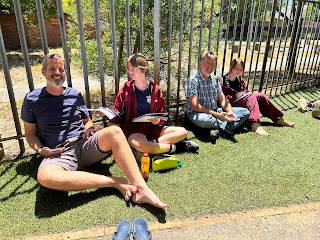Over the years the school has adapted itself from a school we as adults attended, to one that cares about individuals within the whole. Not all children are happy to play outside at breaktime or learn in a room with another thirty children. Realising this has made us create spaces for children to ‘be’ when the world is too overwhelming.
One of the first spaces created was a quiet games space outside my office. We had noticed that some children couldn’t understand the team games at break and would often get into skirmishes with their peers. We regularly place logic games, puzzles, colouring equipment and gender-neutral toys like dolls’ houses and car garages on these tables and we find that pairs of children, even between grades, end up playing quietly in the passage during break and before school. Also, before school the library is open from 7:00. Children arrive at school and race to the library to play board games, complete puzzles or find a little hidden comfortable spot to read on their own. The library is also open until 16:00 in the afternoon and families use this space to read or work together too.
When we first introduced animals as ‘therapy animals’, we used Beck se Plek, named after Buzzy Beck, a former deputy of the school until 1996. In this enclosed outside quad, bunnies, guinea pigs, chickens and ducks live happily together and provide a welcome respite to children during breaktimes. Every single break, children from mainly grade 1 to 3, find an animal to cuddle and feed until the bell rings for class time again. Grade 3 pupils who have consistently assisted with the animals are appointed ‘bunny monitors’, and they wear this name with great pride!
In 2017 the theme of our year was “Pushing Boulders”, named after the book by the same name by Athol Williams. Athol was, at that stage, an uncle of children at the school and is still a famous poet and author. During that year we focused on grit and determination with the children and gave them some strategies to use when confronted with difficult parts of their lives. This space is still used as a quiet space: there is a large chess set to play with and children sit around in quiet groups during breaks, away from the hustle and bustle of the other playgrounds.
Another quiet ‘playground’ is the Mandela Peace Garden. This little quiet garden connected to aftercare, was created by Aunty Suzi, the previous head of aftercare, and a few aftercarians who wanted a calm space to be in the afternoons. They planted indigenous cuttings and collected artifacts such as bird cages, tea pots and fairies to decorate the space.
Learning support has always been a safe place to be: inside the room there are always adults to help children debrief and in the passage there are more games to keep unhappy children busy. A place which was never a safe place for us adults when we were at school, was the staffroom – I remember we weren’t even allowed to walk past that section of the passage! At PNPS children are welcomed into the space: as individuals, as groups to teach and as places to meet. The veranda alongside the staff room is often used as an extra classroom for small groups of children.

This year the staff created Elmer’s Space. Situated in one of the classrooms with two doors permanently open, this space has been decorated with a huge wooden Elmer, created for one of our previous school plays, and two smaller patchwork Elmers, created by the Wyatt family. Shereen Stadler, the deputy, Thaakirah Fritz, our media intern, and I are now based in this space, waiting for staff and children to join us. Sometimes we are joined by children and staff needing support and sometimes children are sent to us for a debrief if their day is not going well. Sometimes this is just a good quiet place to sit when your classroom is too rowdy or a place to quietly recover from a bout of crying. Baloo, my Indian Ringneck parrot, is also based there and he entertains all who go by. Accessibility is the key to this space: the furniture is arranged to make it look inviting and the staff are based on the outside of a horseshoe, which makes the visitors feel included.
For many children at school in South Africa, school is not a safe place to be, but here in the little suburb of Pinelands, all children have many to choose from – a school I wished to attend when I was small!







